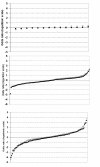Understanding the effects of a decentralized budget on physicians' compliance with guidelines for statin prescription--a multilevel methodological approach
- PMID: 17488496
- PMCID: PMC1885428
- DOI: 10.1186/1472-6963-7-68
Understanding the effects of a decentralized budget on physicians' compliance with guidelines for statin prescription--a multilevel methodological approach
Abstract
Background: Official guidelines that promote evidence-based and cost-effective prescribing are of main relevance for obvious reasons. However, to what extent these guidelines are followed and their conditioning factors at different levels of the health care system are still insufficiently known. In January 2004, a decentralized drug budget was implemented in the county of Scania, Sweden. Focusing on lipid-lowering drugs (i.e., statins), we evaluated the effect of this intervention across a 25-month period. We expected that increased local economic responsibility would promote prescribing of recommended statins.
Methods: We performed two separate multilevel regression analyses; on 110,827 individual prescriptions issued at 136 publicly-administered health care centres (HCCs) nested within 14 administrative areas (HCAs), and on 72,012 individual prescriptions issued by 115 privately-administered HCCs. Temporal trends in the prevalence of prescription of recommended statins were investigated by random slope analysis. Differences (i.e., variance) between HCCs and between HCAs were expressed by median odds ratio (MOR).
Results: After the implementation of the decentralized drug budget, adherence to guidelines increased continuously. At the end of the observation period, however, practice variation remained high. Prescription of recommended statins presented a high degree of clustering within both publicly (i.e., MORHCC = 2.18 and MORHCA = 1.31 respectively) and privately administered facilities (MORHCC = 3.47).
Conclusion: A decentralized drug budget seems to promote adherence to guidelines for statin prescription. However, the high practice differences at the end of the observation period may reflect inefficient therapeutic traditions, and indicates that rational statin prescription could be further improved.
Figures




Similar articles
-
Is physician adherence to prescription guidelines a general trait of health care practices or dependent on drug type?--a multilevel logistic regression analysis in South Sweden.Pharmacoepidemiol Drug Saf. 2009 Aug;18(8):682-90. doi: 10.1002/pds.1767. Pharmacoepidemiol Drug Saf. 2009. PMID: 19437457
-
Understanding adherence to official guidelines on statin prescribing in primary health care--a multi-level methodological approach.Eur J Clin Pharmacol. 2005 Oct;61(9):657-65. doi: 10.1007/s00228-005-0975-9. Epub 2005 Oct 19. Eur J Clin Pharmacol. 2005. PMID: 16133551
-
Is the physician's adherence to prescription guidelines associated with the patient's socio-economic position? An analysis of statin prescription in South Sweden.J Epidemiol Community Health. 2010 Aug;64(8):678-83. doi: 10.1136/jech.2008.081166. Epub 2009 Aug 19. J Epidemiol Community Health. 2010. PMID: 19692716
-
[Statins with a perspective of lifelong therapy].Turk Kardiyol Dern Ars. 2009 Mar;37 Suppl 2:29-36. Turk Kardiyol Dern Ars. 2009. PMID: 19404048 Review. Turkish.
-
Physicians medication prescribing in primary care in Riyadh City, Saudi Arabia. Literature review, part 1: variations in drug prescribing.East Mediterr Health J. 2011 Feb;17(2):126-31. East Mediterr Health J. 2011. PMID: 21735947 Review.
Cited by
-
The median hazard ratio: a useful measure of variance and general contextual effects in multilevel survival analysis.Stat Med. 2017 Mar 15;36(6):928-938. doi: 10.1002/sim.7188. Epub 2016 Nov 25. Stat Med. 2017. PMID: 27885709 Free PMC article.
-
Should hospital pharmacy drug budgets be the responsibility of each individual department in an institution, or should such budgets be controlled centrally by the pharmacy department?Can J Hosp Pharm. 2010 Jul;63(4):330-2. doi: 10.4212/cjhp.v63i4.939. Can J Hosp Pharm. 2010. PMID: 22478998 Free PMC article. No abstract available.
-
Exploring sources of variability in adherence to guidelines across hospitals in low-income settings: a multi-level analysis of a cross-sectional survey of 22 hospitals.Implement Sci. 2015 Apr 28;10:60. doi: 10.1186/s13012-015-0245-x. Implement Sci. 2015. PMID: 25928803 Free PMC article.
-
Practice variation in a longitudinal perspective: a multilevel analysis of the prescription of simvastatin in general practices between 2003 and 2009.Eur J Clin Pharmacol. 2011 Dec;67(12):1205-11. doi: 10.1007/s00228-011-1082-8. Epub 2011 Jun 23. Eur J Clin Pharmacol. 2011. PMID: 21698375
-
Recent national and regional drug reforms in Sweden: implications for pharmaceutical companies in Europe.Pharmacoeconomics. 2008;26(7):537-50. doi: 10.2165/00019053-200826070-00001. Pharmacoeconomics. 2008. PMID: 18563945 Review.
References
-
- Kamps G, Stewart R, van Der Werf G, Schuling J, Jong BM. Adherence to the guidelines of a regional formulary. Fam Pract. 2000;17:254–260. - PubMed
-
- Koutsavlis AT. Disseminating practice guidelines to physicians. Institut national de santé publique du Québec; 2001.
-
- Stewart RE, Vroegop S, Kamps GB, van der Werf GT, Meyboom-de Jong B. Factors influencing adherence to guidelines in general practice. Int J Technol Assess Health Care. 2003;19:546–554. - PubMed
-
- Sjöqvist F, Dahl M-L, Gustafsson L, Hensjö L-O. Drug therapeutics committees: a Swedish experience. WHO Drug Information. 2002;16:207–213.
-
- Socialdepartementet Lag (1996:1157) om läkemedelskommittéer. (Law (1996:1157) about drug committees) [in Swedish]
Publication types
MeSH terms
Substances
LinkOut - more resources
Full Text Sources
Medical

